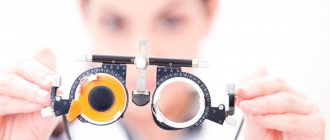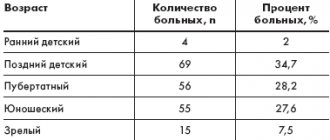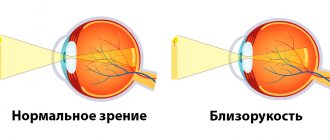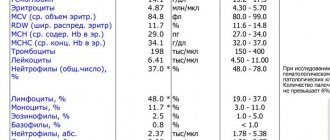Translated from Latin, “accommodation” means “adjustment.” This term entered ophthalmology as a designation for the ability of the eye to equally clearly perceive objects located in the field of view at different distances. The coordinated operation of this mechanism is due to the functional interaction of three elements of the eye: the ciliary muscle, the ciliary ligament and the lens.
In a calm state, the eye is tuned to distance vision. In this case, accommodation is provided by muscles that are in a relaxed state. When you shift your gaze to nearby objects, the ciliary muscle (ciliary) contracts with simultaneous relaxation of the zonules of cinnamon. The consequence of this is an increase in the curvature of the surface of the lens - the elastic transparent element of the eye, responsible for focusing light rays on the retina. The projection of a clear image onto its photosensitive surface is ensured by an increase in the optical power of the lens to 12-13 diopters.
When there is no need for accommodation on nearby objects, the ciliary muscle relaxes, the refractive power weakens, and the eye focuses on infinity. Distance accommodation is also called disaccommodation.
The accommodative function is closely related to the condition of the lens. Clear vision requires its ideal transparency and good elasticity. The lens is most elastic in childhood; With age, mechanical elasticity is gradually lost, which is responsible for the decrease in the acuity of “near vision” in many people after 40-45 years. In this case, age-related farsightedness (presbyopia) is diagnosed. By the age of 60-70 years, the ability to accommodate may be completely lost.
Accommodation in twilight conditions is carried out somewhat differently. In the dark the eye sees only at short distances; disaccommodation “does not work”, the visual system strives to make maximum use of the available level of illumination and focuses on nearby objects. Under such conditions, in a person with a refractive error, hyperopia (farsightedness) decreases by 2.0 diopters, and myopia increases to the same extent. Normal vision behaves like myopia.
Reasons for the development of false myopia
Under optimal lighting conditions, the image on the retina becomes out of focus. This provides an incentive to activate the mechanisms of accommodation. When the projection of rays from objects viewed nearby is focused blurry on the retina, the brain perceives this as a need for correction and sends impulses to the structures responsible for accommodation. This command travels along the oculomotor nerve to the ciliary muscle, causing it to contract. Under the influence of muscle force in combination with relaxation of the zonules of Zinn, the curvature of the lens changes. This adjustment stops at the moment when the image is clearly focused on the retina. Shifting your gaze into the distance again relaxes the ciliary muscle, since focusing in the plane of the retina occurs without its tension, as a result of which the curvature of the surface of the lens decreases and it becomes flatter.
Accommodation spasm can develop under the influence of the following factors:
- exceeding the permissible visual load (reading, watching TV, working at a monitor, sewing and other activities that require constant visual concentration);
- habitually insufficient illumination of the workplace;
- unhealthy daily routine, certain imbalances in work and rest schedules;
- the distance from the work surface to the eyes is too close (often this is allowed by insufficiently attentive parents when the furniture, i.e. the work table and chair, does not correspond to the child’s height);
- bad habit of placing the book too close to the eyes when reading;
- postural disorders associated with weakness of the cervical spine and back muscles;
- blood supply problems in the cervical spine;
- general lack of physical activity.
Sources
- Peinado G.A., Merino Sanz P., Del Cerro Pérez I., Gómez de Liaño Sánchez P. Unilateral accommodation spasm: Case report and literature review. // Arch Soc Esp Oftalmol - 2021 - Vol94 - N6 - p.285-287; PMID:30837173
- Starynets MO., Ocheredko OM. . // Wiad Lek - 2021 - Vol71 - N3 pt 2 - p.628-634; PMID:29783237
- Gedar Totuk OM., Aykan U. A new treatment option for the resistant spasm of accommodation: clear lens extraction and multifocal intraocular lens implantation. // Int J Ophthalmol - 2018 - Vol11 - N1 - p.172-174; PMID:29376009
- Sukhija J., Dogra MR., Zadeng T., Ram J. Functional spasm of accommodation: Changes on scheimpflug imaging. // Oman J Ophthalmol - 2014 - Vol7 - N3 - p.150-2; PMID:25378883
- Lindberg L. // Duodecim - 2014 - Vol130 - N2 - p.168-73; PMID:24605432
- Kanda H., Kobayashi M., Mihashi T., Morimoto T., Nishida K., Fujikado T. Serial measurements of accommodation by open-field Hartmann-Shack wavefront aberrometer in eyes with accommodative spasm. // Jpn J Ophthalmol - 2012 - Vol56 - N6 - p.617-23; PMID:23008062
Accommodation indicators
The ability of the eye to accommodate is measured in diopters or linear values.
- Functional rest of accommodation - disaccommodation - focusing to infinity in the absence of an accommodative stimulus in the visible zone. The accommodation area is the distance along the main optical axis of the eye between the extreme points of clear vision (near and far).
- The volume of accommodation is the range of changes in refractive index, expressed in diopters, when focusing on the nearest and most distant points of clear vision.
- Accommodation stock (reserve) is the unused part of the accommodation capabilities at a certain point in the visual field, located at a given distance.
In the process of ophthalmological diagnostics, absolute and relative indicators of accommodation can be determined. Examination of each eye separately gives absolute values. Diagnosis of both eyes, performed with a certain convergence (reduction) of the visual axes, makes it possible to determine relative indicators.
The functions of accommodation are inextricably linked with convergence. At the same angle of convergence of visual lines, the degree of accommodation in people with different indicators of visual acuity is not the same. For example, uncorrected farsightedness in children (hyperopia) can lead to accommodative convergent strabismus.
Violation of accommodation can manifest itself in the following forms:
- spasm of accommodation;
- paralysis and paresis of accommodation;
- accommodative asthenopia;
- presbyopia (age-related decrease in accommodation).
Children and young people are most susceptible to accommodation spasms. This spasm is caused by functional disorders in the ciliary body, which leads to weakened vision both near and far. The spasmodic ciliary muscle remains in a state of accommodating tension even in situations where its relaxation is required. The development of accommodation spasm is especially facilitated by educational overload; This is why this type of disorder occurs predominantly among schoolchildren and students. According to the results of statistical studies, every sixth student has accommodation disorders caused by muscle spasms.
Paralysis and paresis (partial paralysis) of accommodation can also be a consequence of injuries and the action of toxins. In addition, this type of accommodative disturbances is often provoked by neurogenic factors. In this case, the degree of myopia may not change or increase insignificantly, but the acuity of normal and presbyopic vision decreases at close distances. In any case, paralysis and paresis lead to a reduction in accommodative reserves and a decrease in the overall volume of accommodative capabilities.
Accommodative asthenopia often results from incorrect selection of glasses or lenses for farsightedness and astigmatism. Inadequate optical correction causes rapid visual fatigue, redness of the eyes, itching in the eyelids, dry sclera and an increasing sensation of foreign particles in the eye (chronic blepharoconjunctivitis). Visual discomfort can cause headaches, nausea and even vomiting, which is associated with excessive tension of the eye muscles with limited accommodation reserves.
Age-related accommodation disorders (presbyopia) develop due to gradual involution (reverse development, age-related degradation) of the lens under the influence of external factors and a gradual decrease in the rate of metabolic processes in old age. Over time, the lens loses elasticity, thickens, and becomes less transparent; the eye muscles are no longer able to give it the required curvature and provide sufficient optical refractive power with such changes.
Our advantages
"Moscow Eye Clinic" is a modern medical institution that provides a full range of professional services in the field of ophthalmology. The clinic has at its disposal the best examples of modern equipment from the world's leading manufacturers.
The Clinic employs leading domestic specialists with extremely extensive practical experience. Thus, a surgeon of the highest category Natalia Ivanovna Fomenko consults at the clinic. Thanks to the professionalism of doctors and the use of modern technologies, MGC guarantees the best treatment results and the return of vision. By contacting the Moscow Eye Clinic, you can be sure of quick and accurate diagnosis and effective treatment.
Author:
Mironova Irina Sergeevna 5/5 (1 rating)
Honey. portal:
Symptoms of spasm of accommodation
Signs of false myopia:
- working at close range causes rapid fatigue;
- the eyelids and sclera turn red during visual stress, burning and itching are felt;
- near visual acuity decreases, distant objects also appear blurry or double;
- performance and academic performance decreases;
- headaches occur systematically, especially after visual strain.
Often, the changes that have begun last and progress for years. The person himself perceives them as a natural process of age-related adjustment, although the real reason may lie in physiological visual disturbances that are quite amenable to correction.
Risk group
People of different genders and ages are susceptible to pathology. Violation of accommodative processes is especially common in patients with chronic diseases. At risk:
- children of preschool and school age who are learning to read spend a lot of time reading books or watching TV, smartphones, and computers;
- office workers and people who work on computers;
- people who have been diagnosed with diseases of the vascular system;
- patients who have recently undergone surgery;
- those who work with hazardous substances, chemicals, radiation.
Citizens who are at risk are recommended to visit an ophthalmologist 2-3 times more often than others. If pathological changes are detected in time, treatment can be started promptly and vision can be effectively corrected.
Prevention and treatment of accommodation spasm
False myopia in the absence of adequate treatment and correction leads to the development of true organic disorders. Constant spasm prevents normal vasculature (blood supply) of the ciliary muscle, as a result of which it weakens. This is the mechanism of development, in particular, of chorioretinal dystrophy with functional accommodative weakness. Currently, it is the spasm of accommodation that is considered as the main cause of childhood myopia (first false, and then true myopia).
Our ophthalmological center has everything necessary to identify and effectively eliminate false myopia in both children and adults. The treatment uses not only eye drops and eye exercises, which the patient can do himself at home, but effective hardware techniques that can be used to relieve accommodation spasms in several sessions: quickly and harmlessly!
Treatment of accommodation spasm consists, first of all, in a system of visual exercises and training on special computer simulators. Mydriatic drops (dilating the pupil), laser treatment, magnetic and electrical stimulation are also used. Good results are achieved by massage of the cervical-collar area, the course of which is recommended twice a year. Vitamins and a varied diet are prescribed as general strengthening therapy. For students, it is extremely important to normalize the work and rest schedule, which necessarily includes periods of physical activity.
Drops to relieve spasm of accommodation
Eye drops that dilate the pupil (Irifrin, Tropicamide, Midriacil, etc.) are usually used at night. This makes it possible to provide a relaxing effect on the accommodative muscle that is sufficient in strength and time, while maintaining the patient’s ability to have good vision during the day.
In addition, so-called “vascular and vitamin” drops - Taufon, Emoxipin, etc. - can be prescribed in complex therapy. They improve microcirculation in the tissues of the eyeball and help improve visual functions.
Exercises for false myopia
Gymnastics for the eyes, aimed at training accommodation, primarily involves focusing the gaze on equidistant objects.
The most popular exercise is the so-called “mark on glass”, which consists of the following:
A mark (about 5 mm in size) is attached to the window glass; it can be a small sticker or a spot drawn with a marker or any other means at hand.
After this, you need to move 0.5 meters away from the glass and find a distant object (tree, building, etc.) on the street (behind this mark), then you need to alternately look from the indicated distant landmark to the mark.
The exercise is performed 10-20 times per “approach to the window.” During the day you need to repeat the gymnastics 3-5 times. This allows you to develop a spasmodic accommodative muscle of the eye.
Timely measures taken to prevent spasm of accommodation are effective prevention of more serious disorders accompanying true myopia.
Prices
At the Moscow Eye Clinic you can undergo a full diagnostic examination and receive recommendations on the most effective treatment methods. A comprehensive examination of the patient (including methods such as testing visual acuity, biomicroscopy, autorefractometry, small-pupil ophthalmoscopy, pneumotonometry) costs 3,500 rubles.
The final cost of treatment is determined in each case individually and depends on the specific diagnosis, stage of the disease, available tests, etc.
You can find out the cost of a particular procedure by calling in Moscow 8(499)322-36-36 or number 8(800)777-38-81 (free for all phones in the Russian Federation). You can contact our specialist online using the appropriate form on the website, you can also familiarize yourself with the “Prices” section.
Go to the "Prices" section
Make an appointment
Diagnosis of diseases
During a visual examination, an ophthalmologist can detect a violation of eye accommodation. What it is, what are the causes, symptoms, treatment methods, the specialist will tell you at the initial consultation. Using special tables and instruments, the doctor studies visual acuity and the reaction of the eyes to light. If a violation of accommodative processes is suspected, the following diagnostic measures are carried out:
- refractometry;
- shadow test or skiascopy;
- biomicroscopy;
- Ultrasound.
A set of examinations is prescribed individually. In some cases, consultation with specialists in other fields is required, for example, when the development of pathology is associated with malfunctions of the nervous system.











